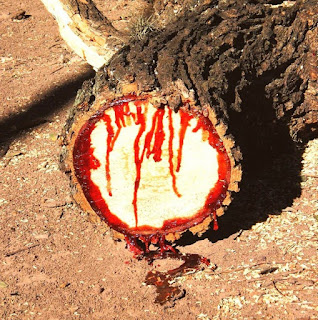Bleeding trees
Bloodwood Trees
There are actually trees that bleeds when cut down like humans. These trees may look like normal trees - but once cut, they "bleed”.Picture courtesy Google images
The Desert bloodwood tree (Corymbia Opaca) the African wild teak tree (Pterocarpus Angolensis) and the Dragon blood tree, (Dracaena Cinnabari) each produce a dark red liquid that looks disturbingly like blood. Therefore, these trees have become commonly known as bloodwood trees Actually. the "blood" seeping out of a damaged bloodwood tree isn't blood – but the red sap that the trees produce when cut, bears a shocking resemblance to human blood. The bloodwood trees get its name from its dark-red sap.
Picture courtesy Google images
The reason behind the dark red colour of its sap is a chemical called 'tannin'- the same as what is found in wine. While the other trees produce white and yellowish sap, bloodwood trees produce red colour sap. Regular plant sap has 12 - 20% tannin. But bloodwood trees have sap that is 77% tannin.
Picture courtesy Google images
Pterocarpus Angolensis is a native wild teak tree of south Africa. Dracaena Cinnabari, the Socotra dragon tree or dragon blood tree, is a dragon tree native to the Socotra archipelago, part of Yemen, located in the Arabian sea. Corymbia Opaca, also known as the desert bloodwood, is a species of tree that is endemic to northern Australia.
The sap of the bloodwood tree is traditionally used as a dye to colour various things.





Informative
ReplyDeleteTHANKS
DeleteResmi Varma
ReplyDeleteThanks
DeleteWoow, blog. This my first time I heard about this tree. 🤔🙏🌴
ReplyDeleteGreat
ReplyDeleteInformative
ReplyDeleteWonderful
ReplyDeleteAwesome
ReplyDeleteAwesome Fam
ReplyDeleteNICE
ReplyDeleteGood info
ReplyDeleteThanks for sharing this info 👌
ReplyDeleteAwesome
ReplyDeleteSuch a great blog! thank you for sharing
ReplyDelete